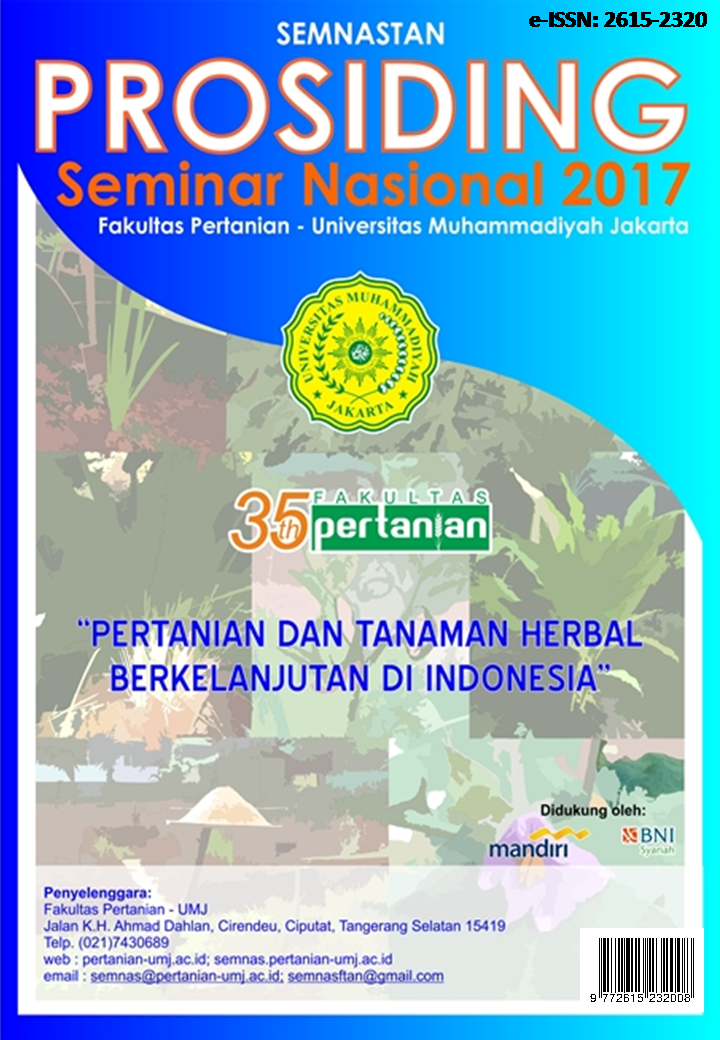UJI AKTIVITAS ANTIOKSIDAN DAN UJI ANTIBAKTERI Fusobacterium nucleatum DARI EKSTRAK ETANOL DAUN Ruta angustifolia
Abstract
Ruta angustifolia atau yang biasa disebut dengan tanaman Inggu telah lama dipercaya dan digunakan oleh masyarakat Indonesia sebagai obat untuk berbagai macam penyakit. Salah satu organ utama yang paling banyak digunakan sebagai obat tradisional adalah daunnya. Inggu telah digunakan secara luas sebagai obat tradisional, namun penelitian ilmiah tentang kandungan bioaktifnya masih jarang dilakukan. Dalam penelitian ini aktivitas antioksidan dan antibakteri daun Inggu diuji terhadap penyakit gigi yang disebabkan oleh Fusobacterium nucleatum. F. nucleatum adalah jenis yang paling umum ditemui pada penyakit gigi dan memproduksi bahan iritan pada jaringan seperti asam butirat, protease dan cytokines.Tujuan penelitian ini adalah menguji kandungan antioksidan dan aktivitas antibakteri ekstrak etanol daun R. angustifolia terhadap F. nucleatum. Metode yang digunakan untuk pengujian antioksidan adalah metode 2,2 diphenyl-1-picrylhydrazyl (DPPH). Uji antibakteri mencakup Uji Konsentrasi Hambat Minimum (KHM) dengan metode serial dilusi-spektrofotometri dan Konsentrasi Bunuh Minimum (KBM) dengan metode streak agar. Dari hasil pengujian kadar antioksidan pada sampel ekstrak etanol daun R. angustifolia menunjukkan nilai IC50 sebesar 100,99 ppm. Hasil ini menandakan bahwa kadar antioksidan pada daun Inggu memiliki aktivitas yang sedang, dengan KHM 40% dan KBM 80%.Kata kunci: Antioksidan, KBM, KHM, Ruta angustifoliaTEST OF ANTIOXIDANT ACTIVITY AND TEST OF ANTIBACTERY Fusobacterium nucleatum FROM EXTRACT ETHANOL LEAF Ruta angustifoliaABSTRACTRuta angustifolia or commonly called the Inggu plant have been trusted for a long time and used by the people of Indonesia as a medicine for various diseases. One of the main organs most widely used as a traditional medicine, is the leaves. Inggu has been widely used as a traditional medicine, however its scientific research on bioactive compound still rare. In this research anoxidant and antibacterial activities of Inggu leaves were tested for dental diseases caused by F. nucleatum. F. nucleatum is the most common type of dental disease and produces irritant substances in tissues such as butyric acid, proteases and cytokines. The purpose of this study is to test the antioxidant and antibacterial activity of R. angustifolia leaf ethanol extract against F. nucleatum in. The method used for antioxidant testing is the 2,2 diphenyl-1-picrylhydrazyl (DPPH) method. Antibacterial tests include Minimum Inhibitory Concentration (MIC) with serial-dilution spectrophotometric method and Minimum Bacteriocidal Concentration (MBC) with streak agar method. The results showed that the levels of antioxidants in ethanol extract of leaves Ruta angustifolia showed IC50 value of 100.99 ppm. These results indicate that the antioxidant levels possessed by these plants have moderate activity, with Minimum Inhibitory Concentration of 40% extract and Minimum Bacteriocidal Concentration at 80%.References
Dewi, F.K. 2010. Aktivitas Antibakteri Ekstrak Etanol Buah Mengkudu (Morinda citrifolia, Linnaeus) terhadap Bakteri Pembusuk Daging Segar. Skripsi. Universitas Sebelas Maret. Surakarta
Jun, M.H.Y., Yu. J., Fong, X., Wan, C.S., Yang, C.T., and Ho. (2003). Comparison of Antioxidant activitiesof isoflavonoids from kudzu root (puereria labata Ohwl). J. Food. Sci. Institute of technologist. Vol 68; p. 2117- 2122.
Keinanen, M. & Ritta, J. T (1996) Effect of Sample Preparation Method on Birch (Betula pendula Roth) Leaf Phenolics. J. Agric. Food Chem, 44 (9), 2724-2727.
Magdalena N.V dan Kusnadi J. (2015). Antibakteri Dari Ekstrak Kasar Daun Gambir (Uncaria Gambir Var Cubadak) Metode Microwave-Assisted Extraction Terhadap Bakteri Patogen. Jurnal Pangan dan Agroindustri Vol. 3 No 1 p.124-135.
Martiningsih N.W ; Widana G A B; Kristiyanti P L M. Skrining Fitokimia Dan Uji Aktivitas Antioksidan Ekstrak Etanol Daun Matoa (Pometia Pinnata) Dengan Metode DPPH. Prosiding Seminar Nasional MIPA 2016,Undiksha.
Mensor, L. L., Menezes, F. S., Leitao, G. G., Reis, A. S., dos Santos, T. C.,Coube, C. S. & Leitao, S. G.(2001). Screening of Brazilian Plant Extracts for Antioxidant Activity by the Use of DPPH Free Radical Method. Phytother. Res.15. 127-130.
Molyneux P. (2004). The use of the stable free radical diphenylpicrylhydrazyl (DPPH) for estimating antioxidant activity. Songklanakarin J. Sci. Technol, 26 (2), 211–219.
Mosquera, O. M., Corea, Y. M. & Buitrago, D. C., Nino J. (2007). Antioxidan Activity of Twenty Five Plants from Colombian Biodiversity, Mem Inst Oswaldo Cruz, Vol 102 (5), 631-634.
Panglossi, H. T (2006) . Antioxidants: New research. New york: Nova science Publishers, Inc.
Roberts, GL. 2000. Fusobacterial Infection : an underestimated threat. British Journal of Biomedical Science 57:156-162.
Sari, N. 2010. Daya Antibakteri Ekstrak Tumbuhan Majapahit (Crescentia cujete L.) terhadap Bakteri Aeromonas hydrophila. Skripsi. Institut Teknologi Sepuluh November.Surabaya
Tambayong, J. (1999). Patofisiologi untuk keperawatan. Jakarta: Penerbit buku Kedokteran: EGC.

